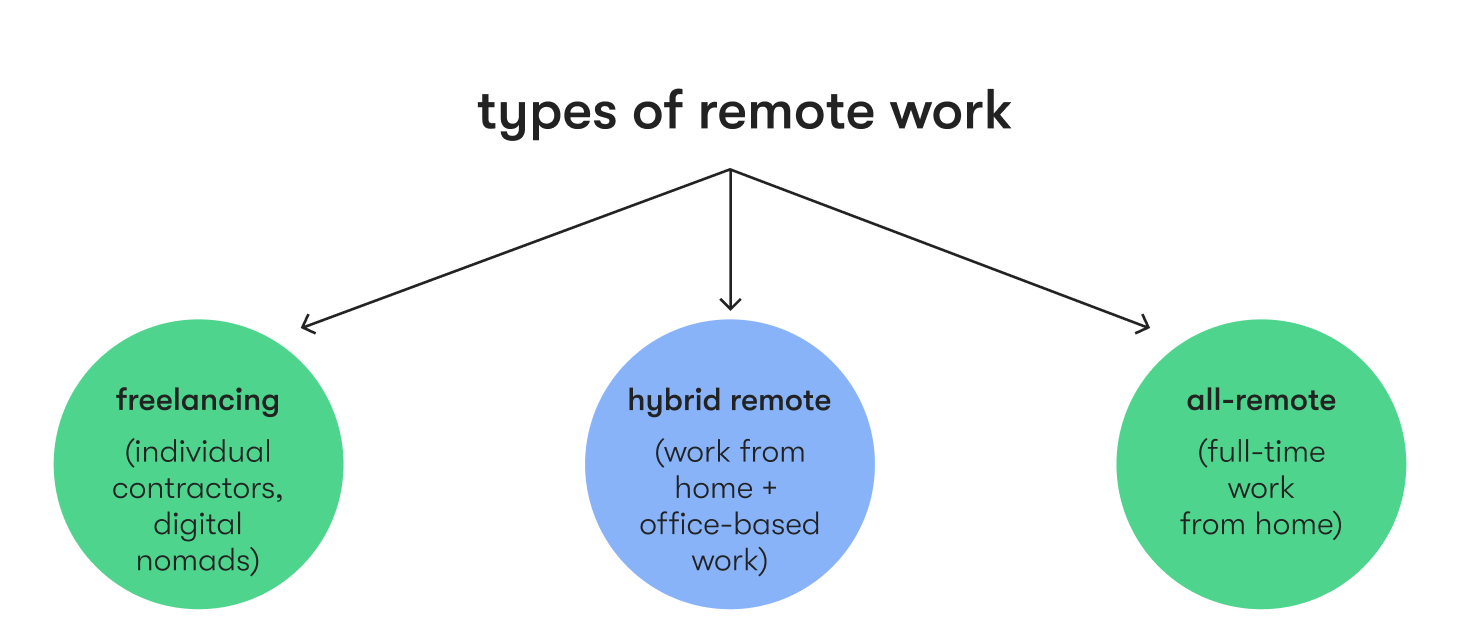Many tech professionals believe that hybrid remote arrangements are the best choice, though some make that determination before learning what the hybrid remote meaning is and how these arrangements function. When these misunderstandings occur, tech employees can find themselves in tough situations.
Since that’s the case, learning the actual hybrid remote meaning is essential. Here’s our 2024 guide to hybrid remote work in tech.
What is hybrid remote work?
Before you start exploring remote work opportunities, it’s critical to answer a few key questions. What is hybrid remote work exactly? What is a hybrid remote job, and how does it differ from some alternatives?
The hybrid remote meaning is reasonably straightforward. In a hybrid remote role, tech professionals spend part of their time working in the office and a portion of their time working remotely from home or other locations.
Generally, hybrid remote roles balance employee-centric and company-centric work models. Generally, time in the office is viewed as favoring employers and managers, as that’s typically the approach they prefer. Remote work is usually considered an employee-focused offering, as an increasing number of tech professionals enjoy working from home or having the flexibility to work while traveling.
This blend of the work-from-home and traditional in-office models varies from one employer to the next. Some companies have relatively strict requirements. For example, they might require employees to be on-site on specific days of the week or during certain operating hours. While this arrangement is a bit rigid, it still qualifies as hybrid remote work.
Other employers offer greater flexibility with their hybrid remote work arrangements. For instance, they might let employees decide which days they prefer to work remotely or in the office. As a result, tech professionals get greater autonomy in these situations. As long as a sufficient number of hours are completed on-site during a set period — such as every week or each month — that’s enough to keep the employer satisfied.
Hybrid remote positions may also be office-first or remote-first. With office-first, there’s a greater expectation to work on-site, though it has a few days of remote work thrown into the mix. Remote-first involves more telecommuting, with the number of required in-office hours being relatively limited.
Hybrid remote vs. all-remote
While the terms “hybrid remote” and “all-remote” are similar, the meaning of hybrid remote differs significantly from the all-remote approach. As mentioned above, hybrid remote schedules involve a mix of in-office time and telecommuting.
While the exact amount of time spent working in each location can vary by employer, both on-site and remote work is part of the hybrid remote equation. Professionals are expected to take advantage of both locations as well as meet minimum on-site attendance requirements.
Since being in the office regularly is part of a hybrid remote job, most employees live in close proximity to the company’s location. As a result, colleagues are potentially accessible in person at any time. If hybrid remote employees need to meet with a team member, they can coordinate a gathering at a coworking space, coffee shop, or similar destination in their town or city. Otherwise, they can wait until they are both in the office together.
All-remote jobs are different. With remote-only jobs, no time is spent in a formal company-supported office. Instead, employees in these positions solely work remotely, often from home or coworking spaces.
When a position is all-remote, the strategy is considered employee-centric. This type of arrangement offers professionals the highest degree of workplace flexibility, as the company doesn’t generally dictate which locations are appropriate. As a result, employees can work from home, head to coworking spaces, use coffee shops, go to family members’ houses, work from hotels, or choose nearly any other spot with a suitable internet connection.
However, all-remote also means not having access to a formal workplace and any associated amenities, such as large office equipment. Additionally, team members are potentially spread out, and there are few opportunities for gathering in person.

What draws the tech workforce to remote work?
In the eyes of tech professionals, there are many advantages to remote work. One of the most significant is the ability to eliminate a commute either entirely or on specific days. Often, this helps achieve a greater degree of work-life balance, as less time is dedicated to getting ready in the morning and commuting to the office.
Remote work also promotes work-life balance in other ways. For example, it can allow employees to care for loved ones who need assistance at home while still handling their job responsibilities. Attending personal appointments may also require less time off if the destinations are nearby, or they can continue working while on the go.
For many, working remotely is also more comfortable. They can design a home office, select a coworking space, or choose another location that provides their ideal environment. Often, for tech professionals who work independently or need to focus on high-detail tasks, this increases productivity. Employees don’t have to face as many distractions if they choose a suitably quiet area, making it easier for them to focus.
In some cases, employees are also less restricted when it comes to the attire they wear while working remotely. While dressing appropriately for video meetings is potentially a necessity, they can don more casual clothing when such gatherings aren’t on the schedule.
Remote work can also come with a greater degree of autonomy since managers aren’t on-site to oversee every action. As a result, it’s easier for professionals to take ownership of their tasks, which can lead to enhanced job satisfaction.
Productivity can also rise when employees work remotely. Fewer distractions and a more comfortable atmosphere both play a role in that. Improved work-life balance can lead to greater engagement, which in turn boosts productivity. Autonomy may also create opportunities to make decisions to improve efficiency.
With hybrid remote work, employees also get the benefits of time in the office. They can gather with colleagues to discuss projects or receive assistance, improving collaboration. Additionally, there are chances to strengthen these relationships in person, which further boosts job satisfaction.
Why hybrid remote work might not be for everyone
While hybrid remote does suit a significant number of tech professionals, it isn’t the best fit for everyone.
- First, designing a functional home office setup isn’t always simple or practical. Not everyone has enough room in their home for a separate office space. As a result, they can end up being distracted by other household members.
- Getting any needed home office furnishing or equipment is a potentially costly endeavor. While the employer may provide basics like a computer, employees usually need to supply their own desks, chairs, paper, pens, and other office supplies. In some cases, workers may have to buy their own printers, scanners, and other equipment, too.
- Working remotely also means covering specific utility requirements. Telecommuting requires reliable internet and a large enough plan to cover the activity occurring over the connection. Additionally, it can lead to higher electricity and water consumption since the employee is spending more time at home.
- If an employee spends their remote days at a coworking space, they typically need to cover an associated rental fee. Working from coffee shops usually requires a purchase to remain in the café for a long period, too.
- At times, connecting with colleagues when a tech professional is working from home or in an off-site location can be challenging. Coworkers aren’t simply a desk or two away, and it can require some coordination to get everyone on a conference call or video chat. As a result, project timelines may slow since it takes longer to share information.
- While there’s greater autonomy while working off-site, it also means there’s less direct oversight. For professionals who prefer a significant amount of feedback or who are newer to their roles and frequently have questions, this lack of guidance may prove problematic.
- Additionally, not everyone is as self-motivated as others. For those prone to procrastination, time spent outside of the office could be less productive, even if there aren’t distractions at home or other alternative locations. In some cases, that may lead to diminished performance that hurts their reputations or chances for advancement.
- Finally, some hybrid remote workers do experience remote work burnout. While that’s more common with all-remote jobs, it can occur in hybrid remote environments, too. When it happens, job satisfaction, productivity, and work quality decline, all of which can harm a person’s personal well-being and professional career.
Can you work remotely from anywhere legally?
Some tech professionals like the idea of telecommuting because it seemingly makes working remotely from another country plausible. However, that doesn’t necessarily mean that you can move away from your original country of employment simply because you’re telecommuting.
In many cases, the reason that working remotely from anywhere isn’t always possible ties into another critical question: if you work remotely, where do you pay taxes? Generally, you pay taxes in the country where you’re a resident.
When you’re working remotely, you need to remain a tax resident in the country where you were initially employed without incidentally becoming a tax resident in another nation based on your travel. The rules that alter tax residency vary – along with the regulations in your country of original employment, the nation you move to or visit could have unique requirements.
While you can usually vacation in other countries without issue, extended stays are potentially problematic. If your tax residency is altered, your tax situation could become complex, and you may lose your eligibility for employment at your current company. In some cases, you could find yourself owing taxes in two countries for the same income, or you might end up terminated by your employer since your changed tax status makes you ineligible for employment.
As a result, many employers that hire remote workers have mobility policies designed to reduce the associated risks. In some cases, this includes pre-approval for short- or long-term relocations. Generally, those rules don’t impact your ability to use vacation time and visit other countries. However, if you intend to work while you’re traveling, specific company rules may apply.
It’s also important to note that working from other countries could have other negative impacts. For example, you could run into issues with your employer-provided benefits, including health insurance, retirement accounts, and similar programs. That’s another reason why companies often have mobility policies in place to avoid the administrative burdens that come with employees moving overseas.
Can you really grow your career as a remote worker?
If you’re asking whether remote workers can climb the career ladder or if there are opportunities for career growth for software engineers doing hybrid remote work, the answer is yes. Many companies actively work to support the development of their remote team members, including providing them with opportunities to acquire new skills and secure promotions.
However, growing your career as a remote worker does require some extra effort. As a telecommuting employee, you’re potentially less visible compared to your in-office counterparts. Additionally, it’s harder to build strong relationships with decision-makers when you aren’t on-site regularly.
Some of the ways to ensure your continuous growth and visibility in a remote work setting include:
- Keeping your lines of communication open. If you want to continue moving your career forward, learn the various remote work communication best practices. Spend time touching base with your colleagues and managers, providing them with status updates to ensure that they can see the effort you’re putting in while telecommuting. Find opportunities to engage face-to-face or through video calls as well. That makes you seem more present than written- or phone-based communication alone.
- Tracking your achievements. By doing so, you’ll have points to present during annual reviews or if you request access to raises or promotions.
- Taking advantage of any training opportunities that arise. This includes programs offered by your employer, as well as efforts outside of the workplace. New skills can make you a more valuable asset, allowing you to advance with greater ease.
- Ensuring your work quality remains high and that all deliverables are submitted on time is also crucial. By doing so, you’re showcasing your capabilities in a meaningful way, highlighting the value you continuously provide your employer.
- Being respectful and supportive. Teach others new skills when opportunities arise and offer assistance to those who are struggling to cement your reputation as a team player.
- Asking for new responsibilities whenever there’s room in your schedule. Volunteering for high-visibility projects is similarly helpful, as it shows you’re passionate about your career and looking for opportunities to help the company succeed.
How to work remotely and live your best life
Working remotely while also living your best life is undeniably possible. In most cases, it’s about finding a suitable balance, ensuring you have time for the activities you enjoy while remaining productive.
One critical aspect of achieving that balance is setting healthy boundaries. When you work remotely from home, your office is typically no more than a few steps away at any given time. Speak with your manager about after-hours expectations and when you’re not required to respond to messages or otherwise engage with work, and during these times, make sure to disconnect completely. That way, you can focus your energies on your personal life without your professional responsibilities becoming an unwanted distraction or burden.
Staying organized is similarly critical. Know what you need to accomplish each workday. Block out time on your calendar for the tasks and use notifications to help alert you when it’s time to transition. Put your breaks on your calendar as well, ensuring that you don’t work through them by mistake.
Have a separate area for work that isn’t in your bedroom, keeping your place for rest separate from areas where you’re active. While you can dress comfortably, avoid pajamas during the workday, as opting for something a bit more cleaned up but also more relaxed than formal workplace attire ensures you’re both comfortable and video call-ready at all times.
It’s also possible to figure out how to work remotely and travel. Review company mobility policies to learn the rules about traveling to other countries without taking vacation time. Additionally, familiarize yourself with tax residency requirements in your home country and your destination nation if you’re planning on visiting for an extended period.
Finally, engaging in fun team-building activities can help you stay connected with your colleagues. Remote work bingo is a popular option, as the bingo cards can be filled with quirky events or activities that can add some joy to your work experience.
Remote work the EPAM Anywhere way
EPAM Anywhere is a remote-first, remote-forever workplace. As Anywhere’s founding company, EPAM embraces hybrid remote work across its locations globally, with the majority of the workforce having been working remotely since the start of the pandemic.
By joining EPAM Anywhere, you can expect to reap the benefits of full-time remote work with no need to commute and the freedom to effectively build a career around your lifestyle, not vice versa.
Getting started is simple. EPAM Anywhere is searching for skilled tech professionals for open positions today. If you’re ready to work remotely the EPAM Anywhere way, check out our available remote tech jobs and submit your application to get one step closer to a fantastic new job.

With a focus on remote lifestyle and career development, Gayane shares practical insight and career advice that informs and empowers tech talent to thrive in the world of remote work.
With a focus on remote lifestyle and career development, Gayane shares practical insight and career advice that informs and empowers tech talent to thrive in the world of remote work.
Explore our Editorial Policy to learn more about our standards for content creation.
read more
















